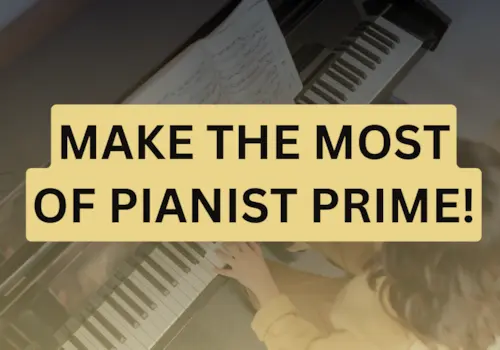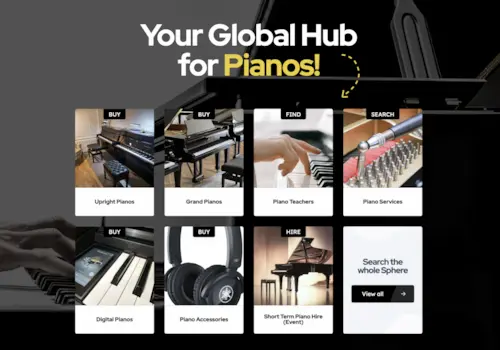If you’re looking for more feedback on how you play, you’ll find that videoing yourself at the piano can be hugely beneficial – and with today’s technology, it’s easier than ever to do. Concert pianist and video blogger Alisdair Hogarth shows you how to get started and what you’ll need
Making a video of your own piano playing can be a revealing – and sometimes humbling – experience, but it is an invaluable aid for being able to assess your own playing and how you might improve it.
While it is certainly helpful to hear yourself performing a piece on an audio recording, it is even more informative to see yourself playing it on a video. When you watch a video, you will notice things that you never realised you were doing physically. Are your shoulders and upper body relaxed? Are you sitting at a comfortable height? Do you execute any particular passages with an excess of energy? Are you preparing your fingers for the positions they are about to occupy? Looking at a video can give you a fresh perspective on your playing.
TIP 1: Start out with some experimentation

Prop your phone up, record a rough take and take a look at your posture
The best way to get started is simply to be experimental. You’ll want to mess around with different options and ideas at first, and have a few practice rounds. If you don’t have high quality camera equipment at your disposal (let’s be honest, not many of us do given the price of it!), the latest iPhones these days have incredible cameras on them. Provided the light is decent, you can get some really excellent results. I’ve filmed some decent video footage on a couple of iPhones at my own concerts.
Start by setting your mobile phone or camera up a few feet from the side of the piano on a table – or propped up on some books if you need more height – so that you can see your entire body, including your feet, to check that you aren’t stamping the pedals, or doing anything weird with the una corda foot! Alternatively, set up your phone or camera with a tripod. There are some great affordable ones available these days. (LINK)

Make a note of how you can improve your seating and posture at the piano
Review the first video and look out in particular for what you do physically before, during and after technically challenging passages; acknowledge it, and then film another performance trying to improve only a few of these things at a time.
TIP 2: Want to invest in some better equipment? Here’s our advice
If you do want to create a more professional video (this will make no change to your chances in the competition. It’s all about your playing!) you might want to invest in more kit. This is a huge topic, but let me suggest some basics, and remember, unless you are trying to make some bit of cinematic history, most videos like this are viewed on a laptop or smartphone, so commercial video quality is not so necessary.
Camera options
If you wanted to produce something of higher quality with a shallower depth of field (meaning the background is blurry and the subject is sharply in focus) which gives the video a more artsy, cinematic look you might want to consider investing in a DSLR [Digital Single Lens Reflex] camera. The most popular brands are Canon and Nikon, which are the cameras of choice for most YouTube vloggers. I use a Canon DSLR for my vlogs. You can browse lots of Canon DSLR options here. They are relatively simple to use and produce broadcast quality results.
Tripod options
If you go for a DSLR, you’ll also need a tripod to go with it. These might be a little different to the tripods mentioned earlier for iPhones. By using a tripod, you will be able to achieve a greater range of angles in your videos and you won’t get jerky footage that looks like you’ve had one too many cappuccinos before picking up the camera. (There are some inexpensive tripods on the market from Manfrotto.)
Microphone options
Sound is obviously highly important when recording music videos. In most cases, using the microphone built into the camera will not produce such good results, and it would be worth investing in a separate microphone that you can plug into the camera. If you have a DSLR, a great microphone is the Røde Video Mic Pro, which mounts on the top of the camera. There are lots of options with varying price points here.
Another option is to record the sound on a separate device, such as a Zoom H1, and then sync up the sound and the picture when you edit the video.
TIP 3: How to edit your video

This leads us to the topic of video editing. For iPhone and iPad users, the iMovie app is inexpensive (£2.99) and perfect for doing basic editing, plus you can add simple transitions between shots and add titles. It is also intuitive to use and boasts a useful help feature that explains what the different tools do on each editing screen. This app is particularly suitable if you are on the move and just want to edit up short videos on the go; you can also upload them easily to YouTube.
If you want something with more features to make your video more individual, there are a range of options. I edit my vlogs with Apple’s Final Cut Pro X, which I find user friendly and fairly easy to use now that I know my way around it. Other options are Adobe Premiere, which you can now purchase on a monthly subscription package that includes other useful editing software such as Photoshop. A third option is Avid, which is used to edit a lot of TV shows. A lot of these applications offer 30-day trials, so it would be worth testing a few out to see which suit you the best.
My advice for learning to use these editing apps is to check out tutorials on YouTube that explain the specific things you want to be able to do. These apps are extremely powerful and have many features that you won’t need for a simple music video, so it is not necessary to learn how to use the entire program.
TIP 4: Make sure your video file isn’t too big!
If you have recorded in HD, the resulting edited video can potentially be an enormous file. Should you then want to upload the video to a sharing site such as YouTube or Vimeo, you’ll need an application that compresses the file. Again, there are lots of apps on the market, depending on exactly what you need it to do. I have found that an app called Compressor by Apple works well with Final Cut Pro and allows me to select the platform that I am going to upload the video on. It will adjust the size for you.
TIP 5: Lighten up
Once you have all the equipment you need for your particular requirements, there are a few practical aspects of recording a video that are worth considering. Firstly, good lighting is extremely important. You can have the fanciest, most expensive camera in the world but if you don’t get the lighting correct, it can look amateurish.

Again there are some helpful tutorials on YouTube about this, but in general, try to avoid positioning the main light source (whether it be from a window, or a lamp) behind the subject, otherwise the result is a silhouette and it can look like you are trying to re-create some kind of dark Tim Burton movie.
TIP 6: It’s all about the angles
To make your videos look more professional, try to incorporate several different angles: maybe a closeup shot of the hands, a side view, a shot through the lid of the piano, even a shot of the feet on the pedals.
Finally, don’t forget that recording is a process, whether video and audio, and you can develop an interpretation through the recording process rather than trying to lay down the perfect track first time. Even in professional recordings, first takes are rarely usable, so enjoy the process of honing your interpretation during each performance. Whatever your reasons for making a video, have fun with it!
The Pianist 2023 Amateur Piano Competition is now open. We are inviting amateur pianists from around the world to enter this brand-new online competition, right from the comfort of your own home.










